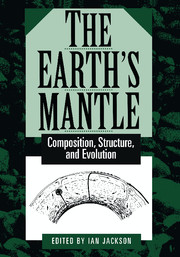Book contents
- Frontmatter
- Contents
- Chapter Outlines
- Contributors
- Dedication
- Preface
- I Accretion and Differentiation of the Earth
- II Dynamics and Evolution of the Earth's Mantle
- III Structure and Mechanical Behaviour of the Modern Mantle
- 8 Seismic Structure of the Mantle: From Subduction Zone to Craton
- 9 Composition and Temperature of the Earth's Mantle: Seismological Models Interpreted through Experimental Studies of Earth Materials
- 10 The Viscosity of the Mantle: Evidence from Analyses of Glacial-Rebound Phenomena
- 11 Mantle Rheology: Insights from Laboratory Studies of Deformation and Phase Transition
- Index
8 - Seismic Structure of the Mantle: From Subduction Zone to Craton
Published online by Cambridge University Press: 23 November 2009
- Frontmatter
- Contents
- Chapter Outlines
- Contributors
- Dedication
- Preface
- I Accretion and Differentiation of the Earth
- II Dynamics and Evolution of the Earth's Mantle
- III Structure and Mechanical Behaviour of the Modern Mantle
- 8 Seismic Structure of the Mantle: From Subduction Zone to Craton
- 9 Composition and Temperature of the Earth's Mantle: Seismological Models Interpreted through Experimental Studies of Earth Materials
- 10 The Viscosity of the Mantle: Evidence from Analyses of Glacial-Rebound Phenomena
- 11 Mantle Rheology: Insights from Laboratory Studies of Deformation and Phase Transition
- Index
Summary
Introduction
Seismological techniques have provided much of the currently available information on the internal structure of the Earth, and in particular on the mantle. Early studies revealed the need for an increase in seismic velocity with depth in the Earth, and by 1915 Gutenberg was able to make a good estimate of the radius of the core. Knowledge of the Earth's internal structure was refined by iterative improvement of earthquake locations and the travel times for seismic phases through the Earth, so that in 1940 Jeffreys and Bullen were able to publish an extensive set of travel-time tables based on a model of both P-wave and S-wave velocities in the mantle. Their velocity profile was intentionally as smooth as possible, but it was not possible to avoid introducing a sharp change in velocity gradient near a depth of 400 km to account for the distinct change in the slope of travel-time curves at a distance of approximately 20° from the source, for both P and S waves. Subsequent studies have refined our conception of mantle structure to reveal the presence of discontinuities in velocity and zones of strong velocity gradients, which have been correlated with mineralogical phase changes (e.g., Jackson and Rigden, Chapter 9, this volume).
The presence of three-dimensional variations in the Earth's structure became apparent in regional differences in seismic travel times, and they became better understood once surface-wave observations demonstrated the significant differences in surface-wave dispersion between oceanic and continental regions (e.g., Knopoff, 1972).
- Type
- Chapter
- Information
- The Earth's MantleComposition, Structure, and Evolution, pp. 381 - 404Publisher: Cambridge University PressPrint publication year: 1998



